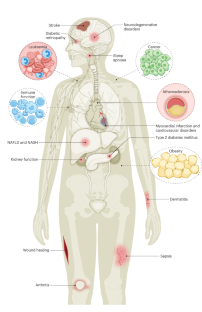Protein tyrosine phosphatase 1B in metabolic diseases and drug development
IF 3.7
3区 医学
Q2 CHEMISTRY, MEDICINAL
引用次数: 0
Abstract
Protein tyrosine phosphatase 1B (PTP1B), a non-transmembrane phosphatase, has a major role in a variety of signalling pathways, including direct negative regulation of classic insulin and leptin signalling pathways, and is implicated in the pathogenesis of several cardiometabolic diseases and cancers. As such, PTP1B has been a therapeutic target for over two decades, with PTP1B inhibitors identified either from natural sources or developed throughout the years. Some of these inhibitors have reached phase I and/or II clinical trials in humans for the treatment of type 2 diabetes mellitus, obesity and/or metastatic breast cancer. In this Review, we summarize the cellular processes and regulation of PTP1B, discuss evidence from in vivo preclinical and human studies of the association between PTP1B and different disorders, and discuss outcomes of clinical trials. We outline challenges associated with the targeting of this phosphatase (which was, until the past few years, viewed as difficult to target), the current state of the field of PTP1B inhibitors (and dual phosphatase inhibitors) and future directions for manipulating the activity of this key metabolic enzyme. This Review summarizes cellular processes and regulation of protein tyrosine phosphatase 1B (PTP1B), discussing evidence from in vivo preclinical and human studies. PTP1B inhibitors, which are being developed for type 2 diabetes mellitus, obesity, rare diseases (such as Rett syndrome) and some cancers, are also discussed.


代谢性疾病和药物开发中的蛋白酪氨酸磷酸酶 1B
蛋白酪氨酸磷酸酶 1B(PTP1B)是一种非跨膜磷酸酶,在多种信号通路中发挥着重要作用,包括直接负向调节经典的胰岛素和瘦素信号通路,并与多种心脏代谢疾病和癌症的发病机制有关。因此,二十多年来,PTP1B 一直是一个治疗靶点,多年来,从天然来源或开发的 PTP1B 抑制剂不断被发现。其中一些抑制剂已进入人类 I 期和/或 II 期临床试验阶段,用于治疗 2 型糖尿病、肥胖症和/或转移性乳腺癌。在本综述中,我们总结了 PTP1B 的细胞过程和调控,讨论了 PTP1B 与不同疾病相关的体内临床前研究和人体研究的证据,并讨论了临床试验的结果。我们概述了与靶向这种磷酸酶相关的挑战(直到过去几年,这种磷酸酶一直被视为难以靶向)、PTP1B 抑制剂(和双重磷酸酶抑制剂)领域的现状以及操纵这种关键代谢酶活性的未来方向。
本文章由计算机程序翻译,如有差异,请以英文原文为准。
求助全文
约1分钟内获得全文
求助全文
来源期刊
CiteScore
7.90
自引率
7.30%
发文量
215
审稿时长
3.5 months
期刊介绍:
Chemical Research in Toxicology publishes Articles, Rapid Reports, Chemical Profiles, Reviews, Perspectives, Letters to the Editor, and ToxWatch on a wide range of topics in Toxicology that inform a chemical and molecular understanding and capacity to predict biological outcomes on the basis of structures and processes. The overarching goal of activities reported in the Journal are to provide knowledge and innovative approaches needed to promote intelligent solutions for human safety and ecosystem preservation. The journal emphasizes insight concerning mechanisms of toxicity over phenomenological observations. It upholds rigorous chemical, physical and mathematical standards for characterization and application of modern techniques.

 求助内容:
求助内容: 应助结果提醒方式:
应助结果提醒方式:


